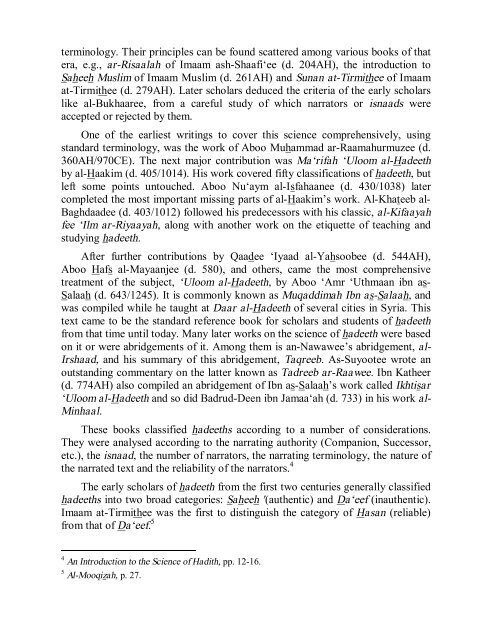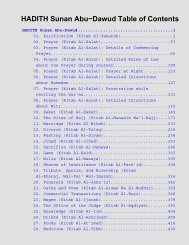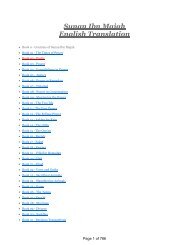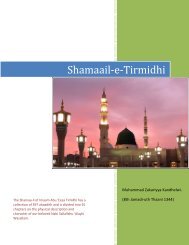You also want an ePaper? Increase the reach of your titles
YUMPU automatically turns print PDFs into web optimized ePapers that Google loves.
terminology. Their principles can be found scattered among various books of thatera, e.g., ar-Risa<strong>al</strong>ah of Imaam ash-Shaafi‘ee (d. 204AH), the introduction toSaheeh Muslim of Imaam Muslim (d. 261AH) and Sunan at-Tirmithee of Imaamat-Tirmithee (d. 279AH). Later scholars deduced the criteria of the early scholarslike <strong>al</strong>-Bukhaaree, from a careful study of which narrators or isnaads wereaccepted or rejected by them.One of the earliest writings to cover this science comprehensively, usingstandard terminology, was the work of Aboo Muhammad ar-Raamahurmuzee (d.360AH/970CE). The next major contribution was Ma‘rifah ‘Uloom <strong>al</strong>-Hadeethby <strong>al</strong>-Haakim (d. 405/1014). His work covered fifty classifications of hadeeth, butleft some points untouched. Aboo Nu‘aym <strong>al</strong>-Isfahaanee (d. 430/1038) latercompleted the most important missing parts of <strong>al</strong>-Haakim’s work. Al-Khateeb <strong>al</strong>-Baghdaadee (d. 403/1012) followed his predecessors with his classic, <strong>al</strong>-Kifaayahfee ‘Ilm ar-Riyaayah, <strong>al</strong>ong with another work on the etiquette of teaching andstudying hadeeth.After further contributions by Qaadee ‘Iyaad <strong>al</strong>-Yahsoobee (d. 544AH),Aboo Hafs <strong>al</strong>-Mayaanjee (d. 580), and others, came the most comprehensivetreatment of the subject, ‘Uloom <strong>al</strong>-Hadeeth, by Aboo ‘Amr ‘Uthmaan ibn as-S<strong>al</strong>aah (d. 643/1245). It is commonly known as Muqaddimah Ibn as-S<strong>al</strong>aah, andwas compiled while he taught at Daar <strong>al</strong>-Hadeeth of sever<strong>al</strong> cities in Syria. Thistext came to be the standard reference book for scholars and students of hadeethfrom that time until today. Many later works on the science of hadeeth were basedon it or were abridgements of it. Among them is an-Nawawee’s abridgement, <strong>al</strong>-Irshaad, and his summary of this abridgement, Taqreeb. As-Suyootee wrote anoutstanding commentary on the latter known as Tadreeb ar-Raawee. Ibn Katheer(d. 774AH) <strong>al</strong>so compiled an abridgement of Ibn as-S<strong>al</strong>aah’s work c<strong>al</strong>led Ikhtisar‘Uloom <strong>al</strong>-Hadeeth and so did Badrud-Deen ibn Jamaa‘ah (d. 733) in his work <strong>al</strong>-Minha<strong>al</strong>.These books classified hadeeths according to a number of considerations.They were an<strong>al</strong>ysed according to the narrating authority (Companion, Successor,etc.), the isnaad, the number of narrators, the narrating terminology, the nature ofthe narrated text and the reliability of the narrators. 4The early scholars of hadeeth from the first two centuries gener<strong>al</strong>ly classifiedhadeeths into two broad categories: Saheeh '(authentic) and Da‘eef (inauthentic).Imaam at-Tirmithee was the first to distinguish the category of Hasan (reliable)from that of Da‘eef. 54 An Introduction to the Science of <strong>Hadith</strong>, pp. 12-16.5 Al-Mooqizah, p. 27.





